This page talks about the fourth Big Issue that we are consulting on as part of the Long Term Plan 2018-28 - Stormwater management and treatment.
Throughout the LTP consultation period, we may update this page depending on the questions being raised, so please keep checking the page for more information. If you have questions, contact us on ourplaceourfuture@timdc.govt.nz
Explore this issue interactively on our StoryMap. Scroll down, then click Stormwater in the top righthand corner.
See below for the sections covered on this page:
- What is stormwater?
- Where are we at?
- What needs to change?
- Options and Preferred Option
- What will these Options mean?
- Frequently Asked Questions
- Have your say
- Supporting Documents and Links
What is stormwater?
Quite simply…it’s the water from a storm....either dumped quickly through an intense thunderstorm or over a longer period of time through a weather front that parks itself over South Canterbury.
In a natural landscape, stormwater is absorbed into the ground or drains into streams, rivers or lakes. In an urban area, stormwater falls onto impermeable surfaces that don’t absorb water - like driveways, roads, or footpaths. The water drains off these surfaces into stormwater infrastructure such as kerbing and stormwater pipes.
Often, it’s just the amount of stormwater runoff that is viewed as the problem. Get a large enough storm and the rainfall can exceed what the infrastructure is designed to cope with.
However, the quality of stormwater runoff is also a problem because this contributes to local water pollution. As the runoff flows across the ground, it picks up pollutants and carries them into local waterways, impacting on local flora and fauna and reducing water quality.
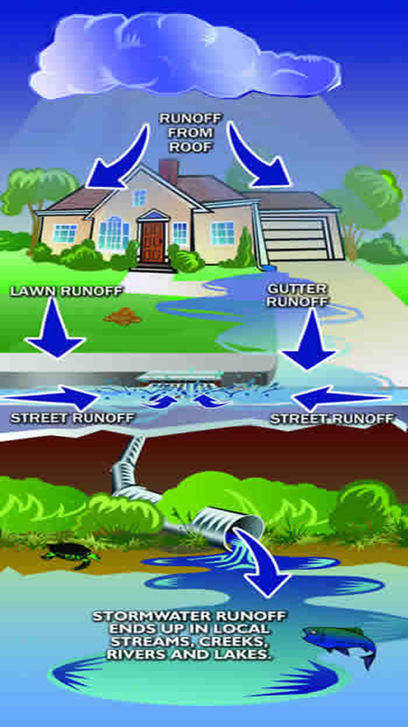
Where are we at?
Council provides a stormwater system in urban areas that enables the transfer of this excess water into waterways while limiting damage to buildings, roads and the natural environment. This system is largely ‘invisible’, built into infrastructure like roads or situated underground. The final location for collected stormwater is the ocean, often via streams and waterways that weave through urban areas.
Work done in recent years includes development of the Timaru District Stormwater Strategy, which sets out the direction for Council’s management of urban stormwater.
For new developments, Council is now making use of “green infrastructure” for stormwater. This includes structures like rain gardens and bunds that capture, slow down, and filter stormwater flows before it enters the piped network.
What needs to change?
New rules and regulations under the Canterbury Land and Water Regional Plan (issued by Environment Canterbury) and National Policy Statement for Freshwater Management (issued by central government) require Councils to up their game in the management and treatment of stormwater. Under the Canterbury Land and Water Regional Plan, Council is required to complete the upgrading by 2025, but this may change in the future.
Our current stormwater management systems require major upgrading to meet new environmental standards, and ensure we are protecting our land and waterways. Council is committed to reducing the level of contaminants that discharge from our stormwater system and improving our environment going forward. Upgrade benefits will also lessen potential flooding damage and risks to properties and infrastructure from stormwater flows.
Options and Preferred Option
How quickly should stormwater system upgrades happen? We have an environmental responsibility to improve the quality of the stormwater that is discharged into our local waterways. We are proposing starting this work in 2018/19, but have options about how quickly funding is gathered from ratepayers to complete the work.
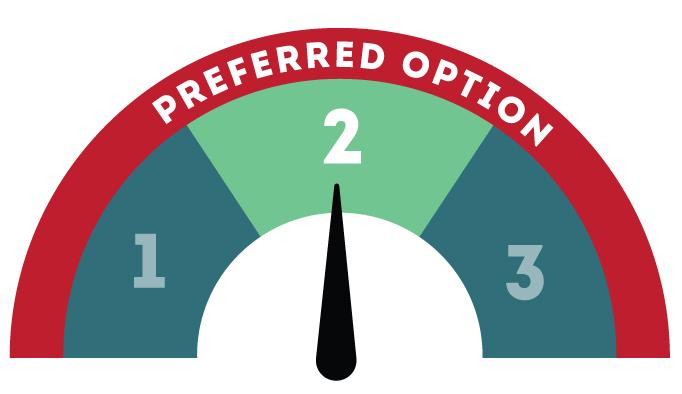
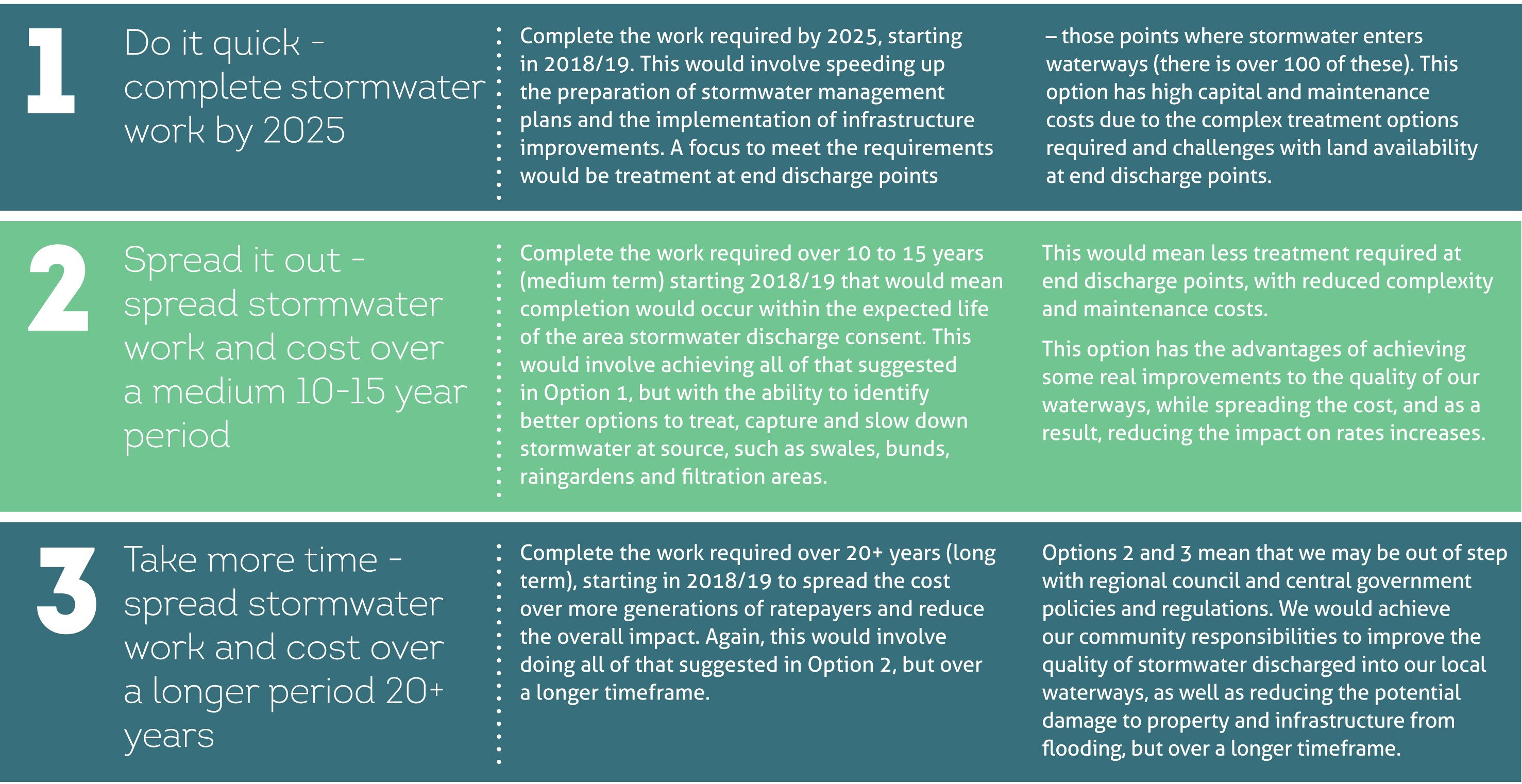
What will these Options mean?
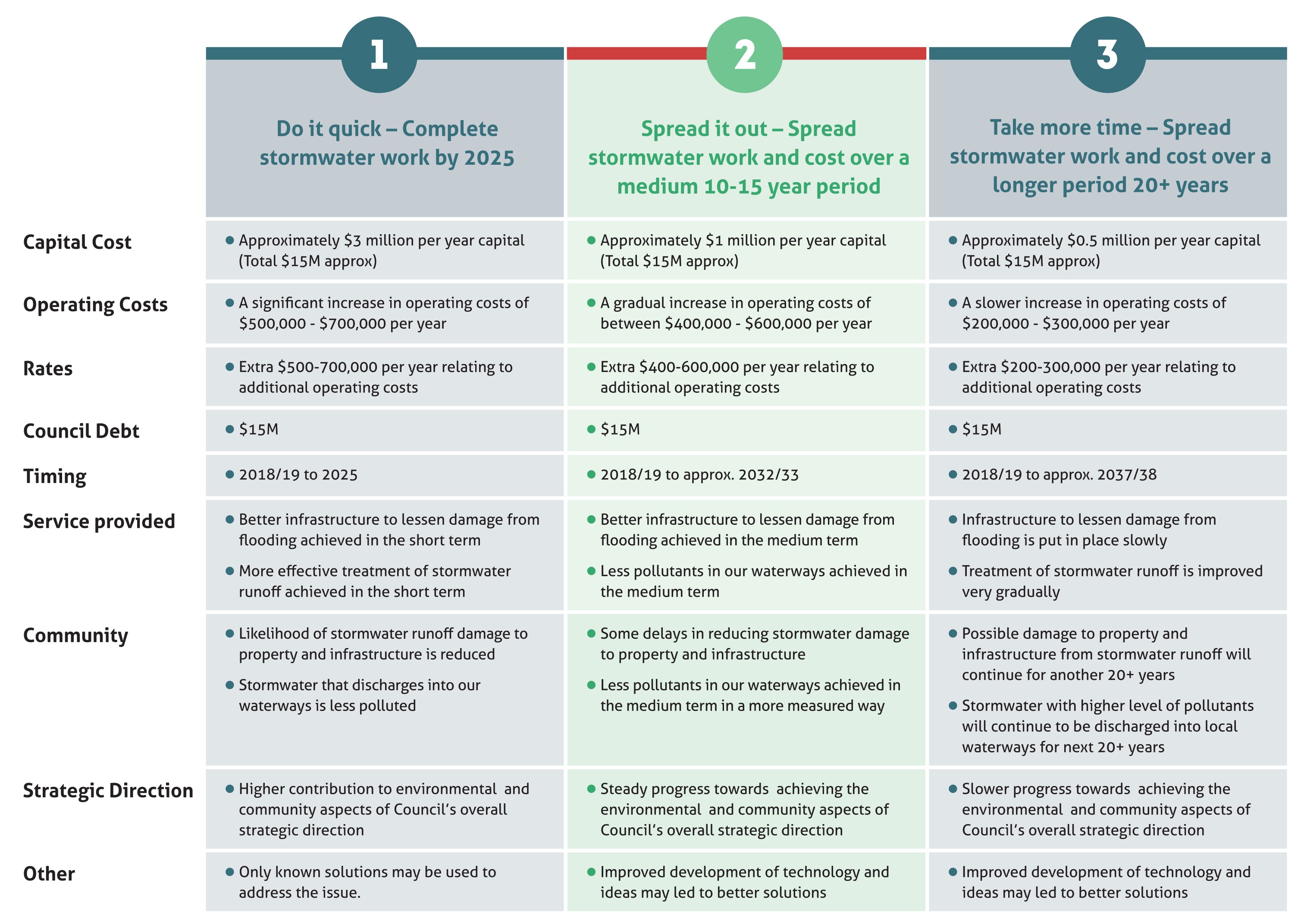
Frequently Asked Questions
Do we have to do this?
Yes we’ve got a responsibility to comply with the Canterbury Land and Water Regional Plan (CLWRP) (issued by Environment Canterbury) and the National Policy Statement for Freshwater Management (issued by central government).
There are new rules and regulations in both of these plans that require Councils to up their game in the management and treatment of stormwater so that it does not contribute to the degradation of the region’s land and water resources. Under the LWRP, Council must demonstrate a commitment to progressively improve the quality of the discharge to meet set water quality standards for receiving water bodies as soon as practicable but no later than 2025 (CLWRP - Activity Policy 4.16e).
What happens if we don’t do it?
Council acknowledges there is a huge task involved in improving stormwater management but doing nothing is not an option for us. Stormwater discharge has the potential to cause adverse effects on the environment and subsequently the well-being of communities. Council has a responsibility to ensure that stormwater is managed in a manner that sustainably supports the environmental, social, cultural and economic well-being of the community.
How does the stormwater get treated?
Stormwater treatment refers to a process of capturing and removing or reducing contaminants in stormwater runoffs. There are quite a few different treatment approaches that aim to slow the flow of the stormwater runoffs and filter out the pollutants. These treatment systems can be thought of as “green infrastructure”. For new developments these types of treatments are required to be considered in the plans as a matter of course. Some examples are explained below:
Rain Gardens
Rain gardens help remove pollutants and slow down stormwater flows, recharge freshwater bodies and look attractive. They filter stormwater through soil mix and plants. These absorb and filter contaminants before stormwater flows to surrounding ground, pipes, drains and streams, and eventually to the sea.
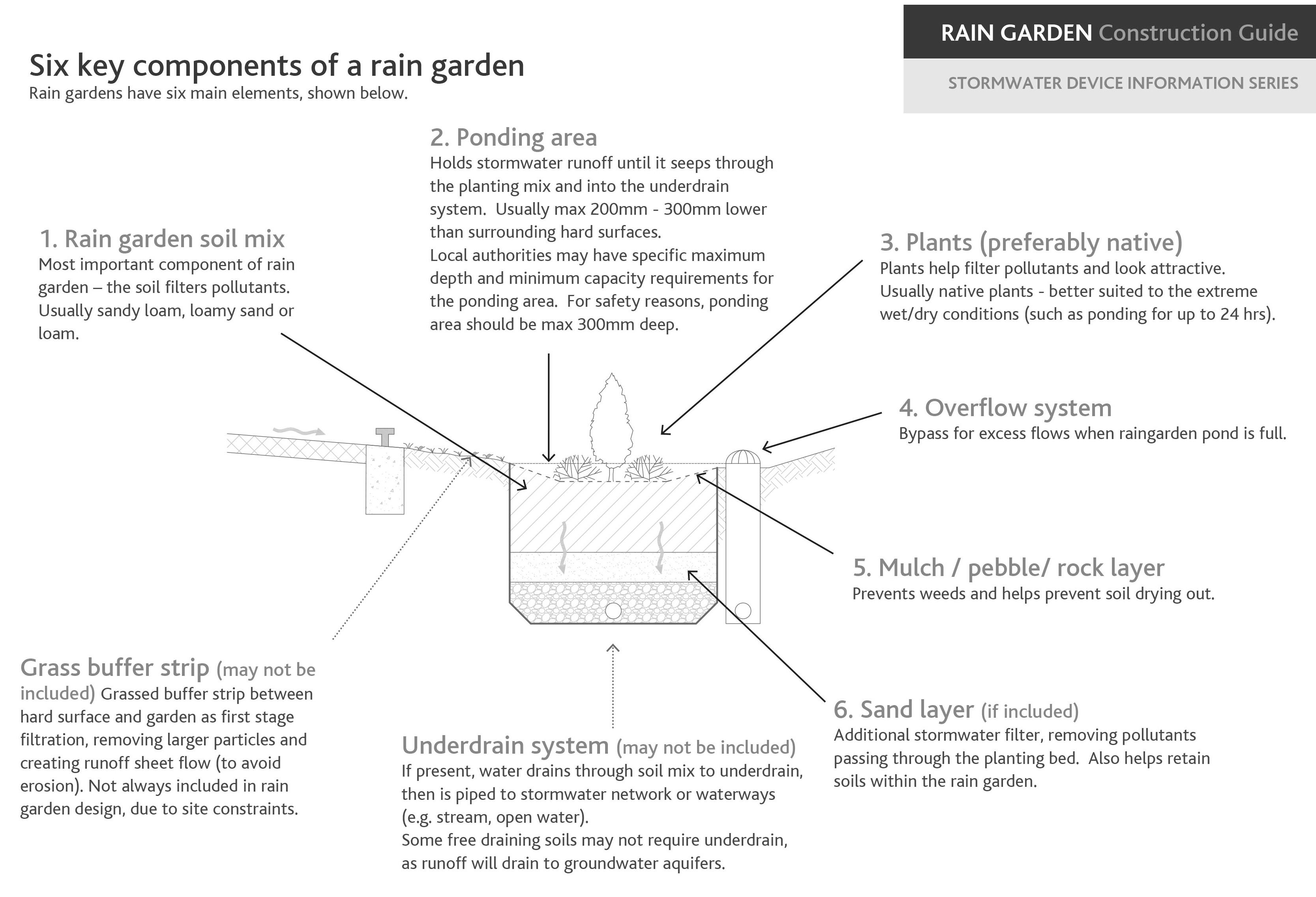
(from Auckland City Council Rain Gardens Construction Guide)
Retention Basins
A retention basin collects and retains water in a storm - collecting and holding it in a pond like structure allows the water to settle – and the chemicals are then filtered and absorbed by the vegetation in the basin.
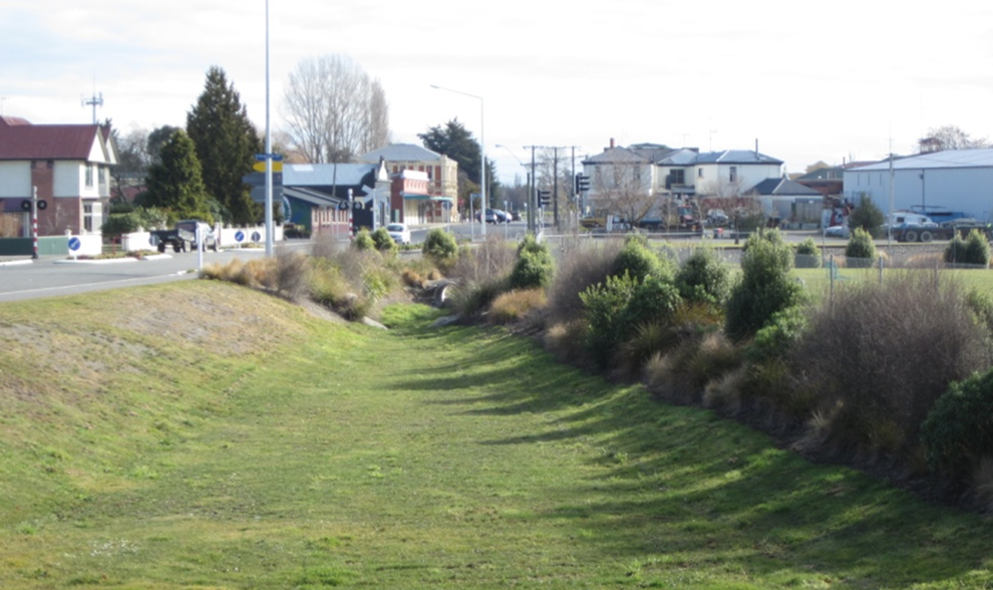
Bunds
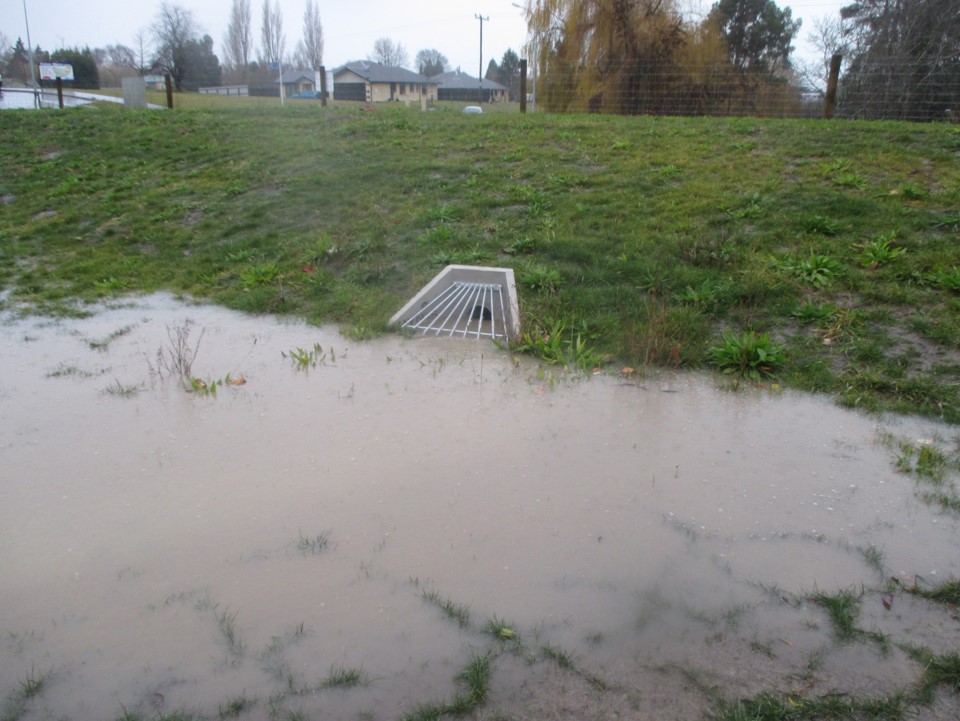
Bunds are similar to retention basins in that the purpose is to hold and filter water.
How is the level of pollutants measured and how will it be collected and analysed?
Stormwater Management Plans will determine the measuring sites and the frequency of monitoring and sampling. It varies depending on the condition, environmental and cultural values of the receiving environment where the stormwater discharges. This will be part of the consent condition to ensure compliance when reporting to Environment Canterbury.
What about if the water from large rainfall events is too much for the capacity of the stormwater system?
For rain event greater than the capacity of the stormwater system, excess stormwater runoff that cannot enter the stormwater network will be conveyed through overland flow paths. It is usually conveyed within the road network system which eventually flows onto land and into rivers and other water bodies.
Will all of this upgrading work mean my property won’t flood?
The short answer is no…. it will help but it isn’t a guarantee. It’s important to remember it is not just stormwater that causes flooding. The amount and intensity of rainfall can be beyond the capacity of the stormwater system. Rivers and streams can overflow due to intense or prolonged rainfall that causes flooding.
Property flooding can also be caused by blocked drains and gutters - not necessarily yours – it could be neighbours. Council has a street cleaning programme that aims to keep gutters clear of leaves and other debris to try and minimise these risks. Homeowners can do a lot too to help by keeping gutters and drains clear on their property.
Pipes can burst – through natural wear and tear, or accidentally – for example a contractor cutting through a water pipe. Although the Council tries to minimise this – with regular pipe maintenance, and contractors do what they can to avoid cutting a pipe – the unexpected sometimes happens.
What about these extreme weather events we seem to be having more regularly?
Currently our urban stormwater reticulation systems are designed for events of less than 1 in 10 year probability. That means they can cope with the type of rain event that has an estimated probability of happening once every ten years.This does not mean that these events will only happen once every ten years.
It is a choice if the community wants a higher level of service. A higher level of service will mean majority of the stormwater network will need to be upgraded to a greater level of service.
What’s the Canterbury Land and Water Regional Plan all about?
The Canterbury Land and Water Regional Plan provides direction on how land and water are to be managed in the region. It applies to everyone (i.e. private landowners as well as councils) who performs activities that have potential to impact on the land and water resources of the region. Council’s stormwater network and drains discharging into land, rivers and other water bodies and it is therefore covered by the rules in the CLWRP.
Some of the most important parts of the plan – that relate to why the Council has to upgrade the stormwater system are to ensure there will be treatment provided to the stormwater prior to discharge into the receiving environment.
- CLWRP – Strategic Policies 4.1 and 4.7; Activity Policies 4.15, 4.16, 4.16A, 4.17; Rule 5.93A – 5.94 (Reticulated Stormwater Systems).
- Water quality standards are in Table 1, Schedule 5 and Schedule 8.
- Policies 4.15b, 4.16 and 4.17; Standards and Limits are in Table 1, Schedules 5 and 8 and Sections 6 to 15 (whichever applies)
Some of the most important timeframes are:
- Strategic Policies 4.1 - Lakes, rivers, wetlands and aquifers will meet the fresh water outcomes set in Sections 6 to 15 within the specified timeframes. If outcomes have not been established for a catchment, then each type of lake, river or aquifer should meet the outcomes set out in Table 1 by 2030.
- Activity Policy 4.16 - Any reticulated stormwater system for any urban area is managed in accordance with a stormwater management plan that addresses the following matters:
- (a) the management of all discharges of stormwater into the stormwater system; and
- (b) for any reticulated stormwater system established after 11 August 2012, including any extension to any existing reticulated stormwater system, the discharge of stormwater being subject to a land-based or designed treatment system, or wetland treatment prior to any discharge to a lake or river; and
- (c) how any discharge of stormwater, treated or untreated, into water or onto land where it may enter water meets or will meet, the water quality outcomes and standards and limits for that waterbody set out in Table 1, Schedules 5 and 8 and Sections 6 to 15,(whichever applies); and
- (d) The management of the discharge of stormwater from sites involving the use, storage or disposal of hazardous substances, and
- (e) Where the discharge is from an existing local authority network, demonstration of a commitment to progressively improve the quality of the discharge to meet condition (c) as soon as practicable but no later than 2025.
What's the National Policy Statement for Freshwater Management?
The National Policy Statement for Freshwater Management provides direction on how local authorities should carry out their responsibilities under the Resource Management Act 1991 for managing fresh water. Some of the key parts of this document from the stormwater perspective are Policy A and Policy B. Policy A requires local authorities to effect measures to help improve or protect water quality in rivers, wetlands and other water bodies. Policy B relates to water quantity in order to safeguard the life support capacity of the ecosystem in fresh water by sustainably managing abstraction, use, damming and diverting of the resource.
Have your say
Want to have your say? Use our consultation submission form.
Supporting Documents and Links
Last updated: 12 Apr 2021